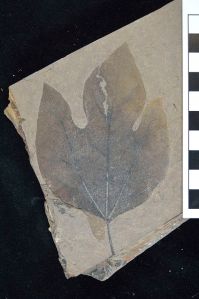I’ve disappeared for a few weeks while I’ve been working hard on my thesis, but now that I’ve finished a draft, it’s time for the next part in my ‘150 things about Canadian palaeo’ series! I’ve focused mostly on animals, but of course, there are also palaeobotany sites in Canada, and here’s a few facts about Canadian palaeobotany. Starting at 104/150:
104. The McAbee Fossil Beds in British Columbia are a Provincial Heritage Site that represent the Eocene, approximately 50 million years ago. This deposit is an old lake bed, with many fish and insect fossils, but also it’s extraordinary fossil plants. Many groups of plants including several similar to pines, gingkoes, maple and more that are found today.

105. As an undergraduate student, we took a field trip in our palaeobotany class to Joffre Bridge, an amazing palaeobotany locality near Red Deer, Alberta. The fossils here date back to the Late Paleocene, approximately 60 million years ago, only 5 million years or so after the dinosaurs went extinct. At this time, flowering plants (angiosperms) were rapidly dispersing and diversifying, and a number of different groups can be found here.
106. Fossils from Joffre Bridge are so abundant and well preserved, that palaeobotanists have been able to study the entire lifecycle of some plants, even from seedlings. Seedlings are rarely found in the fossil record, but Joffrea seedlings are commonly found here.
107. Fossils of early land plants from the Devonian (410 million years ago) were found in 1955 on Bathurst Island, Nunavut. Some fossils found here are even earlier, living as long as 423 million years ago, including some of the earliest land plants. These plants are very different from plants today, lacking seeds and leaves, and consisting mostly of stems and roots.
108. Also in Nunavut, Axel Heiberg Island is known for its fossils forests from the Eocene. Unlike today, 45 million years ago saw this area home to large, flourishing wetland forests of redwoods, ferns, and angiosperms. Many of these plants are not mineralised like most fossils, which has lead some to suggest they are more mummified than fossilised.
109. The oldest fossil pine tree was found in Nova Scotia, and dates back 140 million years ago. Preserved in charcoal, it looks very similar to a modern pine.
110. And although it’s cold now, Canada was once home to palm trees! Earlier this year, a new species of fossil palm tree was described after being found in 1995 near Edmonton, Alberta. This palm was smaller than what we’re used to today, and dates back to the Paleocene, about 65 million years ago. While Canadian palm fossils had previously found earlier (Cretaceous) and later (Eocene), this fossil filled a gap in the record.
Well that was only a small introduction into the world of Canadian palaeobotany, so I hope that you enjoyed it. There are lots more localities and specimens, but unfortunately it’s a field I know little about. If there are any other significant plant localities or finds from Canada, please let me know!
The series:
Part 3: Early Canadian Palaeontologists
Part 5: Dinosaur Provincial Park
Part 7: Current Canadian Palaeos (1)
Part 8: Dinosaur Fossil Localities
Part 10: Joggins Fossil Cliffs
Part 11: Significant Canadian Fossils
6 thoughts on “Palaeobotany – 150 things about Canadian palaeo, part 14”